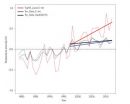(Press-News.org) Extremely hot temperatures over land have dramatically and unequivocally increased in number and area despite claims that the rise in global average temperatures has slowed over the past 10 to 20 years.
Scientists from the ARC Centre of Excellence for Climate System Science and international colleagues made the finding when they focused their research on the rise of temperatures at the extreme end of the spectrum where impacts are felt the most.
"It quickly became clear, the so-called "hiatus" in global average temperatures did not stop the rise in the number, intensity and area of extremely hot days" said one of the paper's authors Dr Lisa Alexander.
"Our research has found a steep upward tendency in the temperatures and number of extremely hot days over land and the area they impact, despite the complete absence of a strong El Niño since 1998."
The researchers examined the extreme end of the temperature spectrum because this is where global warming impacts are expected to occur first and are most clearly felt. As Australians saw this summer and the last, extremely hot temperatures in inhabited areas have powerful impacts on our society.
The observations also showed that extremely hot events are now affecting on average more than twice the area when compared to similar events 30 years ago.
To get their results, the researchers examined hot days starting from 1979. Temperatures of every day throughout the year were compared against temperatures on that exact same calendar day from 1979-2012. The hottest 10% of all days over that period were classified as hot temperature extremes.
Globally, on average regions normally expect around 36.5 extremely hot days in a year. The observations showed that during the period from 1997-2012, regions that experienced 10, 30 or 50 extremely hot days above this average saw the greatest upward trends in extreme hot days over time and the area they impacted.
The consistently upward trend persisted right through the "hiatus" period from 1998-2012.
"Our analysis shows there has been no pause in the increase of warmest daily extremes over land and the most extreme of the extreme conditions are showing the largest change," said Dr Markus Donat
"Another interesting aspect of our research was that those regions that normally saw 50 or more excessive hot days in a year saw the greatest increases in land area impact and the frequency of hot days. In short, the hottest extremes got hotter and the events happened more often."
While global annual average near-surface temperatures are a widely used measure of climate change, this latest research reinforces that they do not account for all aspects of the climate system.
A stagnation in the increase of global annual mean temperatures, over a relatively short period of 10 to 20 years, does not imply that global warming has stopped. Other measures, such as extreme temperatures, ocean heat content and the disappearance of land-based ice all show continuous changes that are consistent with a warming world.
"It is important when we take global warming into account, that we use measures that are useful in determining the impacts on our society," said Prof. Sonia Seneviratne from ETH Zurich, who led the study while on sabbatical at the ARC Centre.
"Global average temperatures are a useful measurement for researchers but it is at the extremes where we will most likely find those impacts that directly affect all of our lives. Clearly, we are seeing more heat extremes over land more often as a result of enhanced greenhouse gas warming."
INFORMATION: END
No warming hiatus for extreme hot temperatures
2014-02-26
ELSE PRESS RELEASES FROM THIS DATE:
Beta-catenin alters T cells in lasting and harmful ways
2014-02-26
Activation of beta-catenin, the primary mediator of the ubiquitous Wnt signaling pathway, alters the immune system in lasting and harmful ways, a team of Chicago-based researchers demonstrate in the February 26, 2014, issue of Science Translational Medicine.
An increase in beta-catenin in certain types of T cells—a class of white blood cells—causes chronic inflammation in the intestine and colon, eventually leading to cancer. The same mechanism is used by colon cancer to propagate itself. The researchers combine data from patients suffering from colitis or colon cancer ...
Hubble monitors supernova in nearby galaxy M82
2014-02-26
This is a Hubble Space Telescope composite image of a supernova explosion designated SN 2014J in the galaxy M82. At a distance of approximately 11.5 million light-years from Earth it is the closest supernova of its type discovered in the past few decades. The explosion is categorized as a Type Ia supernova, which is theorized to be triggered in binary systems consisting of a white dwarf and another star — which could be a second white dwarf, a star like our sun, or a giant star.
Astronomers using a ground-based telescope discovered the explosion on January 21, 2014. This ...
Characterization of stink bug saliva proteins opens door to controlling pests
2014-02-26
Brown marmorated stink bugs cause millions of dollars in crop losses across the United States because of the damage their saliva does to plant tissues. Researchers at Penn State have developed methods to extract the insect saliva and identify the major protein components, which could lead to new pest control approaches.
"Until now, essentially nothing was known about the composition of stink bug saliva, which is surprising given the importance of these insects as pests and the fact that their saliva is the primary cause of feeding injury to plants and crop losses," said ...
New data book outlines Hispanic/Latino health
2014-02-26
The National Heart, Lung, and Blood Institute, part of the National Institutes of Health, released the largest and most comprehensive health and lifestyle analysis of people from a range of Hispanic/Latino origins. The data will enable individuals, communities, and policy makers to tailor better health intervention strategies.
"This study lays the foundation for future research on the possible causes of chronic diseases and ways to prevent them, and to help us understand the reasons why Hispanics and Latinos live longer than the general population," said Gregory Talavera, ...
Research maze puts images on floor, where rodents look
2014-02-26
PROVIDENCE, R.I. [Brown University] — A rodent in a maze is a staple — even a stereotype — of experimental psychology research. But the maze in the lab of Rebecca Burwell, professor of cognitive, linguistic, and psychological sciences at Brown University, is not your grandfather's apparatus. In a new video article published in the Journal of Visualized Experiments, Burwell's research group demonstrates in full detail how the maze can be used to perform automated visual cognitive research tasks with great efficiency.
The article is available here: http://www.jove.com/video/51316/automated-visual-cognitive-tasks-for-recording-neural-activity-using
The ...
Mayo Clinic discovers African-Americans respond better to rubella vaccine
2014-02-26
ROCHESTER, Minn. — Feb. 26, 2014 — Somali Americans develop twice the antibody response to rubella from the current vaccine compared to Caucasians in a new Mayo Clinic study on individualized aspects of immune response. A non-Somali, African-American cohort ranked next in immune response, still significantly higher than Caucasians, and Hispanic Americans in the study were least responsive to the vaccine. The findings appear in the journal Vaccine.
"This is fascinating," says Gregory Poland, M.D., Mayo Clinic vaccinologist and senior author of the study. "We don't know ...
JILA physicists discover 'quantum droplet' in semiconductor
2014-02-26
BOULDER, Colo -- JILA physicists used an ultrafast laser and help from German theorists to discover a new semiconductor quasiparticle—a handful of smaller particles that briefly condense into a liquid-like droplet.
Quasiparticles are composites of smaller particles that can be created inside solid materials and act together in a predictable way. A simple example is the exciton, a pairing, due to electrostatic forces, of an electron and a so-called "hole," a place in the material's energy structure where an electron could be, but isn't.
The new quasiparticle, described ...
Pine forest particles appear out of thin air, influence climate
2014-02-26
Pine forests are especially magical places for atmospheric chemists. Coniferous trees give off pine-scented vapors that form particles, very quickly and seemingly out of nowhere.
New research by German, Finnish and U.S. scientists elucidates the process by which gas wafting from coniferous trees creates particles that can reflect sunlight or promote cloud formation, both important climate feedbacks. The study is published Feb. 27 in Nature.
"In many forested regions, you can go and observe particles apparently form from thin air. They're not emitted from anything, ...
A predictive fitness model for influenza
2014-02-26
Researchers at Columbia University and the University of Cologne have created a new model to successfully predict the evolution of the influenza virus from one year to the next. This advance in our understanding of influenza suggests a new, systematic way to select influenza vaccine strains. The findings appear in Nature on Feb. 26.
The flu is one of the major infectious diseases in humans. Seasonal strains of the influenza A virus account for about half a million deaths per year. In a concerted effort, WHO and its Collaborating Centers have closely monitored the evolution ...
Sunburns strike twice
2014-02-26
Melanoma is particularly dangerous because it can form metastases in vital organs such as the lungs, liver or brain. UV radiation is considered to be the most significant triggering factor. An interdisciplinary team of researchers from the University Hospital and the LIMES Institute of the University of Bonn has now discovered that sunburns contribute to the development of this malignant disease not only through direct alteration of pigment cell genomes but also indirectly through inflammatory processes in the surrounding tissue. The results are now being published online ...




